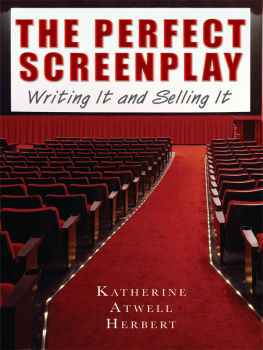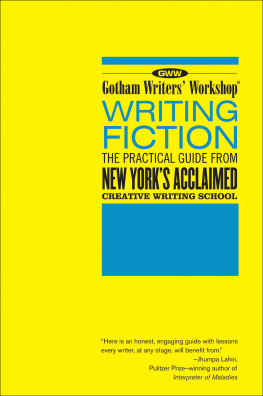HOW TO WRITE A SCREENPLAY
A Basic Guide
By Dorian Scott Cole
Copyright 1994 Dorian Scott Cole
Edition 3, 2016
Published by Dorian Scott Cole at Smashwords
ISBN: 9781310212963
Smashwords Edition License Notes
This ebook is licensed for your personalenjoyment only. This ebook may not be re-sold or given away toother people. If you would like to share this book with anotherperson, please purchase an additional copy for each recipient. Ifyoure reading this book and did not purchase it, or it was notpurchased for your enjoyment only, then please return toSmashwords.com or your favorite retailer and purchase your owncopy. Thank you for respecting the hard work of this author. Seeschool copying permissions under .
Table of Contents
- The Quick Start
: briefdescriptions and links to in-depth information
What to write
: story illustration
Acknowledgements
Funds for printing the original guide wereprovided to National Writers Workshop by The American FilmInstitute, partly because of the nonprofit nature of NationalWriters Workshop and its assistance to screenwriters. The AFI doesnot endorse (or not endorse) this guide nor did it contributefinancially in any other way. The author is not compensated in anyway for this guide.
Disclaimer
This is an original work. Any similarities toany person, living or dead, or any organization, or any otherliterary work, are strictly coincidental.
Images
Coverimages licensed from Microsoft Word clipart and MorgueFile.com
Cover: Original design with Microsoft Wordclipart and MorgueFile.com images, by Dorian Scott Cole
Hit and Run - Quick Start
Everyone likes to jump right in and startwriting, and that's good. Use this Quick Start to begin creatingyour screenplay right away. Keep in mind that screenplays looknothing like novels and plays. They have their own way of doingthings. So you probably should look at Format.
Use this Quick Start for a handy reference todetailed information as you write. Have a great time and goodluck!
Format Example
INT. CHRIS HOUSE KITCHEN DAY
(Slugline: INT = Interior, EXT = exterior)
Description of the scene, and the characters in thescene when it starts. The first time characters appear, their namesare in ALL CAPS, and this is followed by their description.
(Action style.)
Example: CHRIS, 50ish, holds a hot dog stick in afireplace, and wears a cowboy hat. NICKY, late twenties, sits on achair watching him.
CHARACTER NAME
(INSTRUCTION or PARENTHETICAL [usually notused])
Dialogue. (3 inches)
More scene information. (Style: Action)
The font for the entire script is Courier orCourier New, size 12.
Note that the exact format can't beformatted correctly in an ebook.
What To Write
Write about what interests you. It will bemore fun and if it interests you it is more likely to interestothers. It's also best to know something about what you are writingabout, or have the ability to research it first hand, or throughothers, or by finding information.
The following would be helpful to writeabout:
Unusual things and surprises really getattention (but don't get too radical).
Humor can be a helpful element in any story,but too much humor spoils it.
Careful: if the outcome of the story ispredictable, readers will go, "ho-hum."
One page equals about one minute of screentime, so shoot for ten to thirty pages, which is typically aboutthree to thirty scenes. Hint: it's easier in some ways to writethirty pages than ten because shorter stories require moreintensity.
Writing Methods
Many people like to just start writing.Others like to write parts of the story that they find exciting,and then go back and write the rest. Others like to write asynopis. Many use a combination of all of these methods.
Use the method best suited to you - just getstarted. At some early point you should write out the plot or storyline so you don't waste time writing stuff that doesn't belong. Ifyou are in a writing class, your teacher may want you to focus on aspecific method.
Making FascinatingCharacters
Creating characters who have real wants andneeds is a great place to start. Often the best stories comestraight from the characters.
Create your main character and an opposingcharacter, then a couple of friends. Throw them together in asituation where they're struggling for something they want, andthere it is - the story writes itself.
Get in-depthinformation
Dramatic Structure - howstories flow
Stories most commonly have three acts...exciting acts! You can write your own synopsis using this one as anexample. You'll be surprised how easy it is.
Act I grabs our attention like cool drinks ona hot beach. Main characters dazzle us with their entrances, andshow us a problem we're soon dying to see solved, but it blows upinto a big crisis: somebody wants something really, really badly!For example, Tom wants to star in the basketball final, needs tocomplete his rock collection for geology, but needs an A on hiscalculus final to pass high school, both are tomorrow - and hehasn't studied all semester!
The crisis launches us into Act II, whichwill be about fifty percent of the story. There the main character(Tom) struggles to get his prize. But the problems get bigger andbigger, draining his strength and destroying his will. The onlyperson in town who has the rock he needs, is Tom's worst enemy. Tomsprains his ankle. He realizes all this talk in calculus abouttriangles was about math, not art. And his girl friend is dumpinghim... and dumped his rock collection over 80 city blocks. Beatenand broken, he must do the impossible - which moves the story intoAct III.
We're on the edge of our seats going into ActIII! Will Tom win this final battle and get his rock collectiongathered from eighty city blocks (where his angry girl frienddumped them), and ace the calculus test, and win the ball game witha sprained ankle? Some way Tom discovers something about himself,succeeds at something important and learns something in theprocess. Easy, isn't it? Dramatic structure is explained in moredetail in a sample story line, Prom Date.
The following are parts of dramaticstructure:
Plot
What is going to happen in your story? Thebasic plot is a result of the main source of conflict, whichcreates tension. Plots have to have conflict to keep our interest.Tension comes from the main characters opposing each other orstriving for something. Then all of the details that drive thestory this way and that make up the full plot. Writing the fullstory without knowing the plot, is a gamble that everything willwork, and frequently it doesn't.
Scene
The scene is the fundamental building blockof screenplays. It lasts an average of one to three minutes andtakes place in one location. When the location or time changes, itis a new scene. Think of scenes as situations that are like amini-story.
Dialogue
Dialogue is what people say: their exactwords without quotation marks or he said, she felt, sheremembered, etc. Each line of dialogue should be as short aspossible - don't have your characters talk like you talk to yourfriends.
Set-ups and Characters For Short Scripts
Ten to twenty page short scripts make specialdemands on character and plot. Make it easier on yourself - readmore about this.
Format
Screenplays follow an easy format; and ifthey're not in it, no one will read it.
Rewriting: The best kept secret inHollywood
Some mistakes will earn you the title ofamateur. Avoid these things and you'll look good on paper or acomputer screen.
Getting Feedback
The best thing to do is talk to others aboutyour story and get their input (unless you're very sensitive). Askothers what they would do in a situation similar to yourcharacter's. (Not an expanded topic.)
Next page

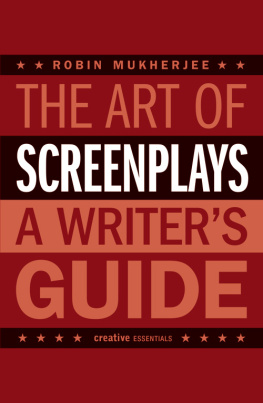

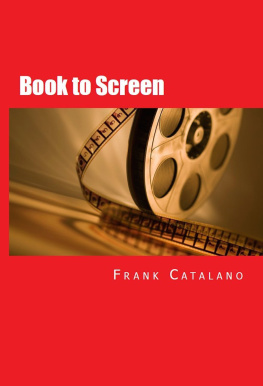
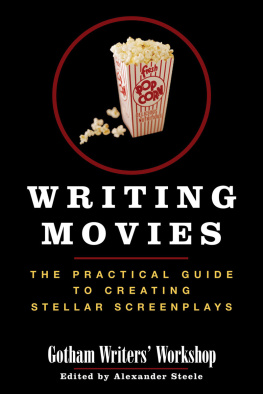
![Watt - The 90-day screenplay : [from concept to polish]](/uploads/posts/book/103527/thumbs/watt-the-90-day-screenplay-from-concept-to.jpg)
